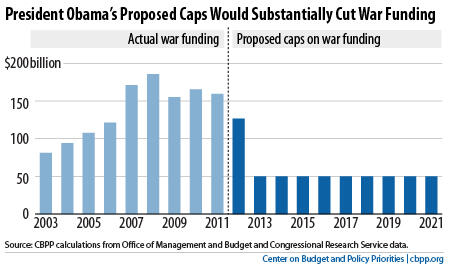BEYOND THE NUMBERS
The recent debt-ceiling deal limited the Pentagon’s non-war funding — but not its funding for the wars in Iraq and Afghanistan. The President has now proposed to cap funding for the wars as well, and he counts $1 trillion in savings over ten years from doing so as part of his $4 trillion in total proposed budget savings. Some maintain that the $1 trillion in war savings are “phony” or a “gimmick.” We ourselves previously suggested that the savings should be reflected in the budget “baseline” rather than counted as part of the total savings a deficit-reduction plan achieves. Nevertheless, the President’s proposal itself is sound.

For starters, it’s worth noting that, in his controversial budget plan last spring, House Budget Committee Chairman Paul Ryan claimed as deficit reduction the very same $1 trillion in war savings and cited an estimate by the Congressional Budget Office (CBO) to back him up. CBO says that the proposed cap on war costs produces savings of this size, relative to its official budget baseline.
To be sure, the plan to substantially reduce war expenditures does not represent a new Obama policy. That’s why some argue that shrinking war costs should be built into the spending “baseline” instead of counted as savings from the baseline.
Rather than debate whether such savings should be built into the baseline, we should keep the following important points about capping war costs in mind:
- Arguing about baselines is far less important than agreeing on policies to achieve the goal of stabilizing the debt as a share of the economy — a goal that the President’s proposal appears to achieve by 2014. Whether the savings from limiting war funding are built into the baseline or counted as deficit reduction from a baseline that does not include them makes no difference to the bottom line — the spending, deficits, and debt resulting from the plan are the same in either case. Whether one achieves, say, $4 trillion in savings from the official CBO baseline or $3 trillion in savings from a baseline that already assumes these savings and hence shows lower deficits, the end result is identical. Moreover, the proposed cap on war spending will help to lock in planned war savings and increase prospects that those savings will materialize.
- War spending is now lower than in 2008, but the proposed cap would reduce it further, as the graph below shows. Spending substantially less than in the past is a spending reduction, even if not a new policy.
- Locking in the war savings now, as the President proposes, prevents a later congressional proposal to enact $1 trillion in new tax cuts or new spending increases and “pay for” them by capping war costs, validated by a CBO cost estimate. Better to dedicate the war savings to deficit reduction now, as the President proposes, even if you don’t consider them new savings. His proposal thus prevents a future budget gimmick that would worsen our fiscal picture.
- The President’s proposal advances the goal of fiscal responsibility in another important respect, as well. As long as war costs remain uncapped, the Pentagon can classify various ongoing expenditures as “war costs” — and thereby increase its budget by more than the caps on “security” funding enacted in last month’s Budget Control Act would otherwise allow. It is widely thought that the Pentagon did just that during the Bush years, when Congress did not look closely at “emergency” defense funding. And National Journal Daily reported on September 20 that “Senate appropriators moved nearly $10 billion — more than a third of the cuts mandated by the Budget Control Act approved by Congress in August — from the Pentagon’s base budget to the separate accounts that pay for operations in Iraq and Afghanistan.” Capping war costs now would help close this loophole; if it’s not done, Congress could well use the loophole to further shrink the savings that the Budget Control Act is supposed to produce. Here, as well, the President’s proposal would forestall a gimmick that could otherwise be employed to make the fiscal picture worse.
The bottom line is that this is a sound proposal that advances the cause of fiscal responsibility and helps prevent future budget gimmicks that would set us backward. That is far more important than a fruitless debate over which budget baseline to use and whether to “count” the reduced war expenditures as savings — especially since the President’s plan appears to reach the goal of stabilizing the debt regardless of which baseline one uses and whether one counts these as savings.
